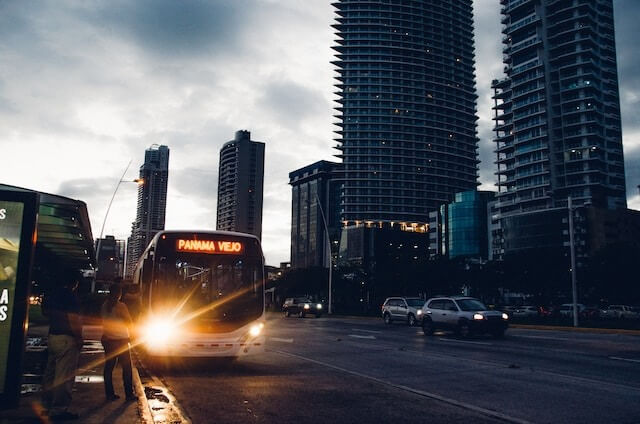Panama boasts an effective road system, though some drivers are known to take risks on the roads. A car may not always be necessary unless visiting nearby towns; otherwise public transportation should provide ample options.
Buses in Panama City offer the ideal mode of transport. Departing from Gran Terminal Nacional, prices depend upon distance traveled.
Taxi
Panama City can be easily navigated with the metro bus system and well-marked taxis; drivers tend to be friendly and willing to strike up conversations if you can speak Spanish, particularly if the conversation can continue while riding one.
Hailing a taxi can be tricky. Taxi drivers may refuse to take you where you need to go if it’s nighttime, during peak traffic hours, or they may try overcharging or don’t know the correct fare amount.
Avoid these issues by hiring a driver for at least a day or two and familiarizing yourself with all the available transport options within the city. Over time, you should become adept at hailing cabs without hassle or hesitation.
Find licensed, registered taxis in Panama City easily with their yellow color and number plates on either side. While some drivers use meters, others employ zone-based systems which calculates fares based on how many zones are crossed; recently however, services like Uber have appeared that offer slightly lower rates than traditional taxis.
Due to Panama’s busy streets and bumpy roads, renting a car should generally not be recommended; if you do decide to drive a rental, however, be sure to possess both an international driving license as well as two types of coverage: collision/robbery insurance as well as liability for third parties (known locally as cobertura de terceros o responsabilidad civil). Most traveler or home auto policies usually include this coverage but it’s best to double check ahead of time.
Past generations relied upon diablo rojos for transportation around Panama City, however these colorful buses are being gradually phased out in favor of more comfortable and convenient Metrobuses which operate over 140 routes – providing a comprehensive transport option in Panama City. To take advantage of them, purchase a Metro card.
Bus
Bus systems in Costa Rica are extensive and well-organized, yet their operation may differ from what you might be used to in your own country. A typical trip on most Metro buses will cost just $0.25 no matter the distance; however if a bus bears either “Corredor Norte” or “Corredor Sur” on its signboard it will charge extra for using toll roads; you should always ask either your driver or another passenger whether your destination falls on one of these routes before embarking.
Recently, Panama has made significant efforts to upgrade and modernise its aging transport network. Now boasting a pioneering subway train line that helps alleviate chronic traffic jams on city streets; plus an impressive array of modern air-conditioned buses running throughout its capital city.
Domestic flights are an efficient way to explore Panama, but tour groups offer more comprehensive access. There are multiple airports throughout the country but Marcos A. Gelabert airport serves cities along its isthmus as well as Bocas archipelago and Comarca de Guna Yala (San Blas Islands).
Rental cars offer visitors who want to explore Panama at their own pace the freedom and independence they require, provided that you possess valid documents such as passport and proof of onward/return travel plans, credit card, collision/robbery coverage (cobertura de colisiones y robo) as well as third-party liability (cobertura para danos a terceros or responsabilidad civil). It’s wise to check whether traveler’s or homeowners’ policies cover car-rental damage beforehand as many do cover car-rental damages when renting/collecting.
Diablos Rojos
Diablos Rojos or “Red Devils”, as they were popularly referred to, earned their name as they drove at suicidal speeds through Panama City’s streets with brightly painted, loud and unruly public buses that often broke traffic laws while beeping their horns and intimidating and angering anyone in their path. But now thanks to President Martinelli’s initiative of replacing them with modern metro buses which offer safer, cleaner service at faster rates – thus earning their nickname.
Sofia Verzbolovskis has captured some poignant photographs that document the last diablos before they vanish from Panama’s streets, reflecting both their vibrant cultural histories as well as the sadness over their departure.
Panama is not alone in using retired American vehicles as public transportation; similar programs exist throughout Latin America such as Guatemala, Honduras, and Ecuador. Old school buses are recycled for public shuttle use after being sent to garages where they undergo restoration, repair and modification before being decorated to reflect their origin and route.
Diablos rojos were beloved vehicles among Panamanians despite their loud, dangerous and unruly natures. Their popularity caused a boom in their industry with private entrepreneurs quickly importing vehicles of their own import to open franchises for them quickly – though their lack of government regulation contributed to Panamanian traffic jams.
However, as the Diablos rojos era comes to a close and new Metro Buses start arriving, most Panamanians may look back fondly on these cultural icons. Even though their logistics proved challenging at best, these sensational buses provided an immersive sensory experience while serving as a reminder of Panama’s rich cultural and historical background.

